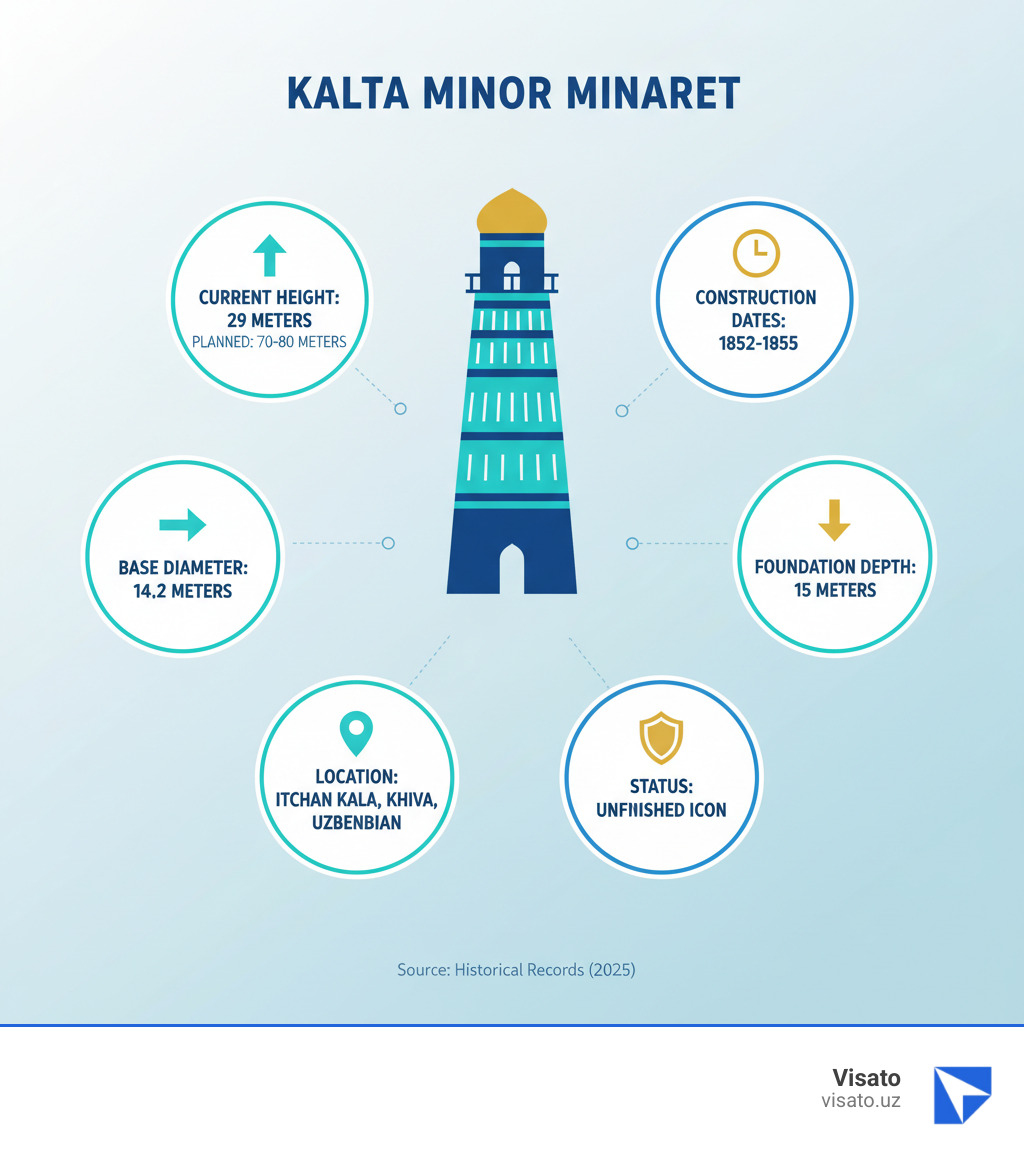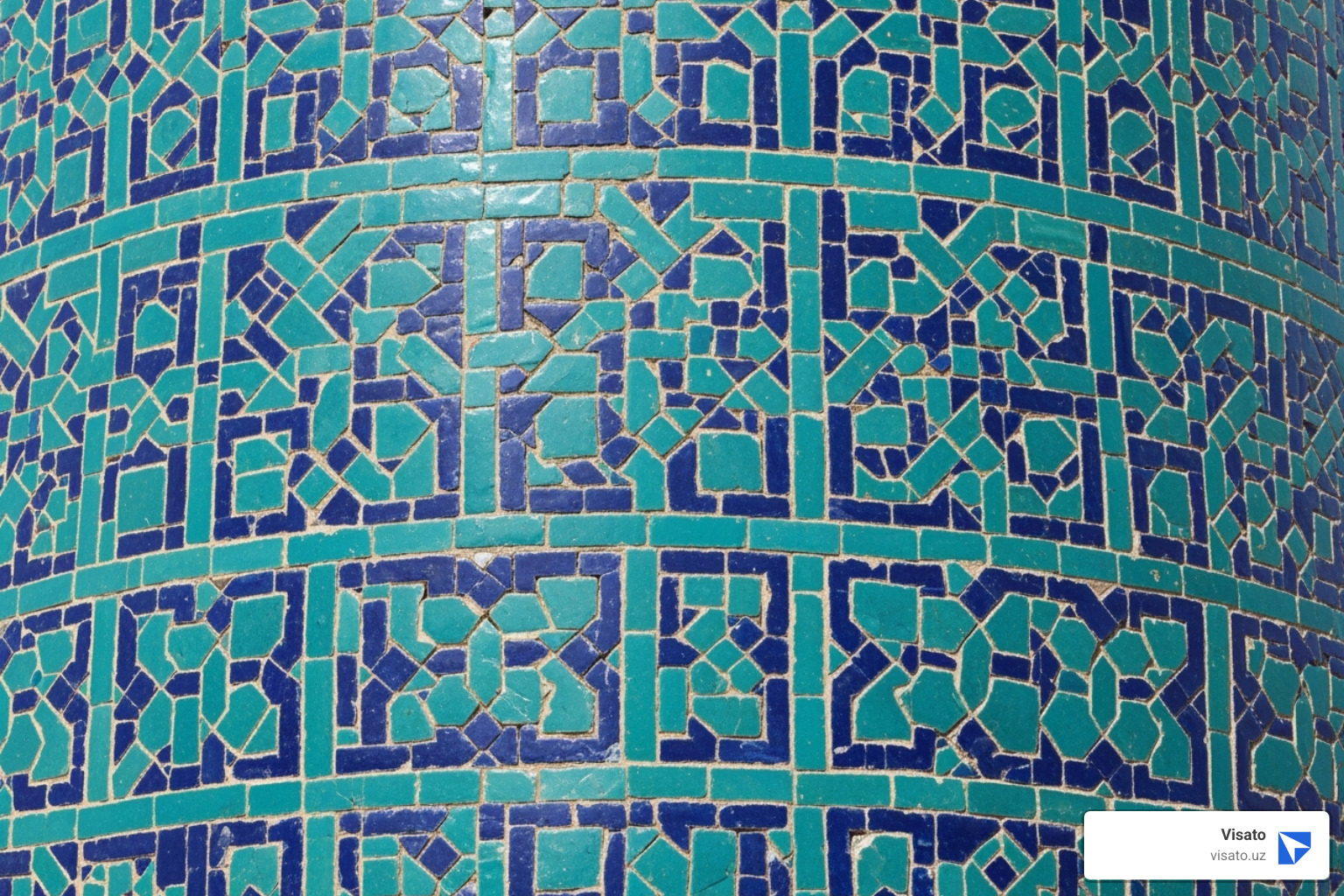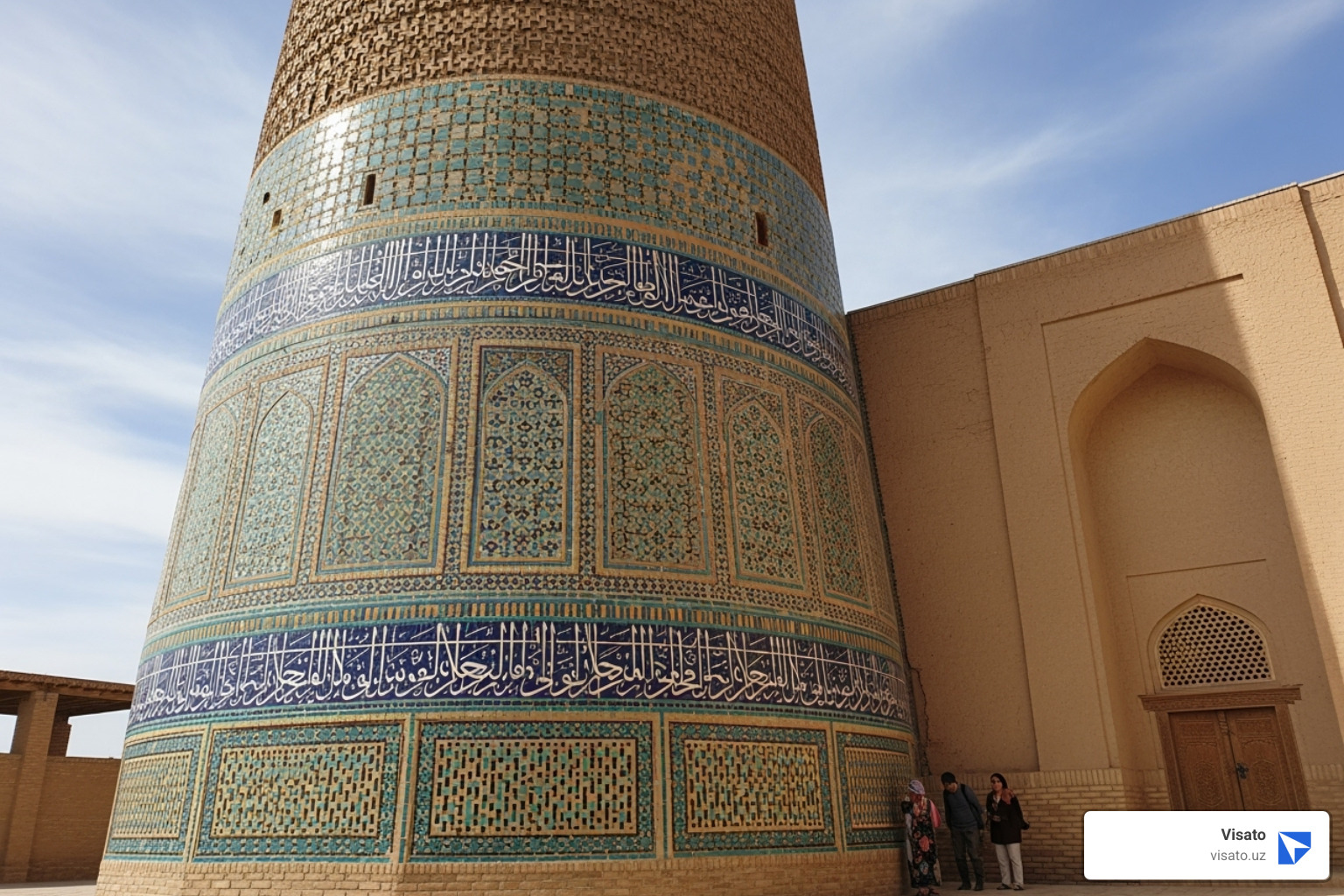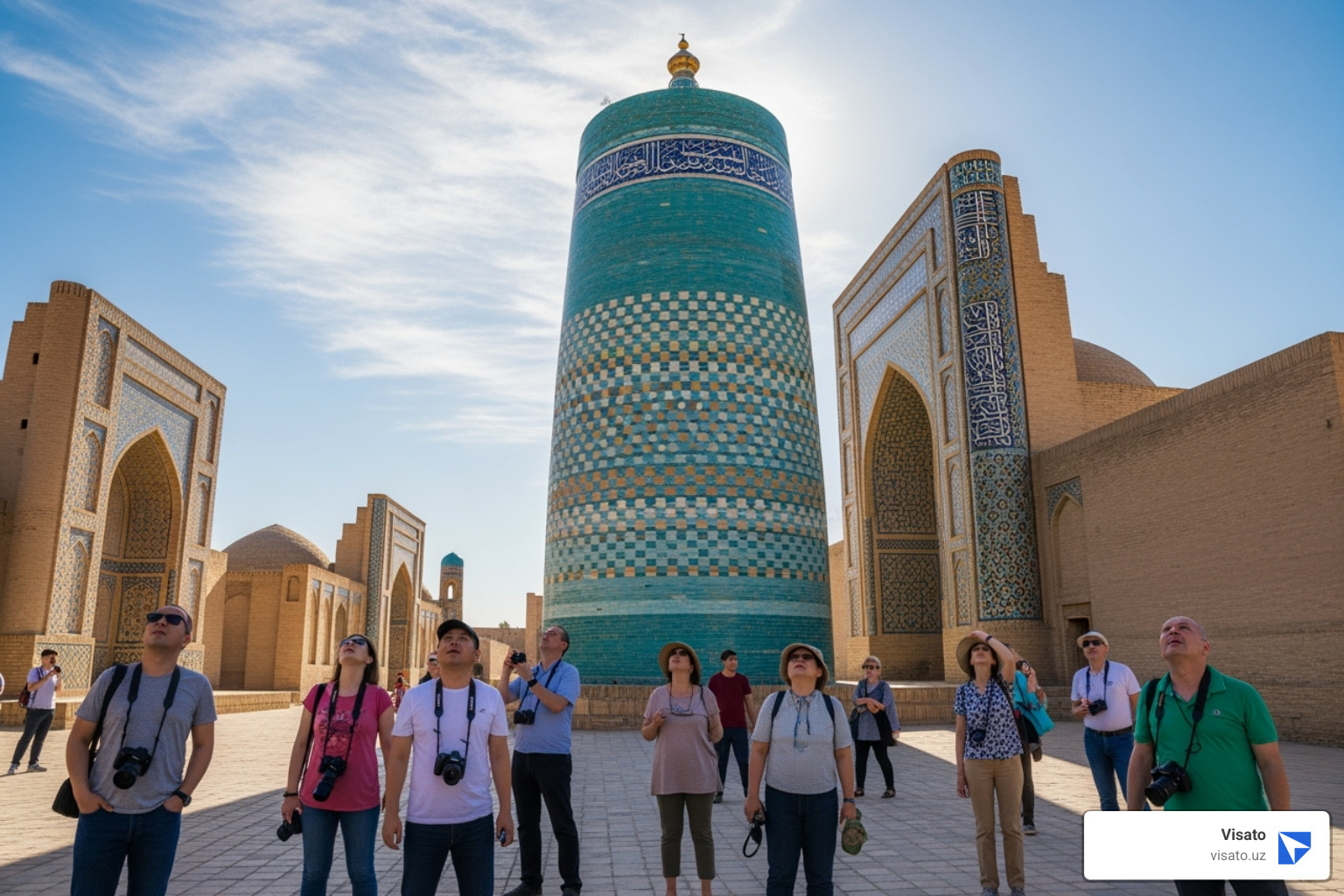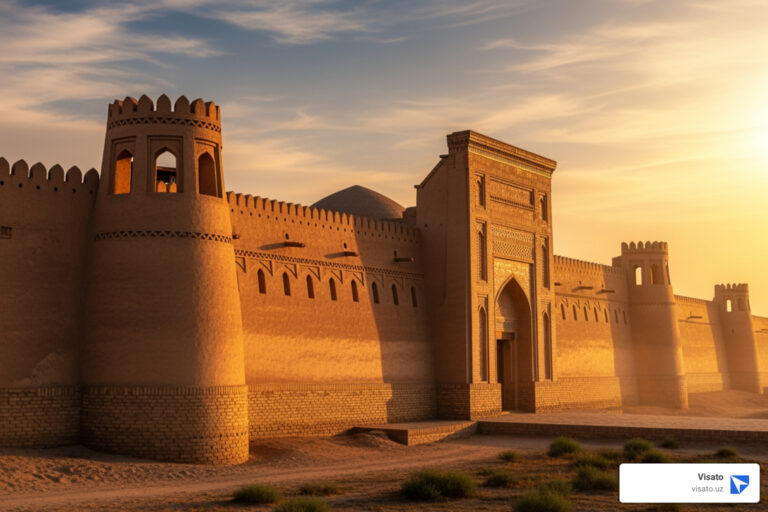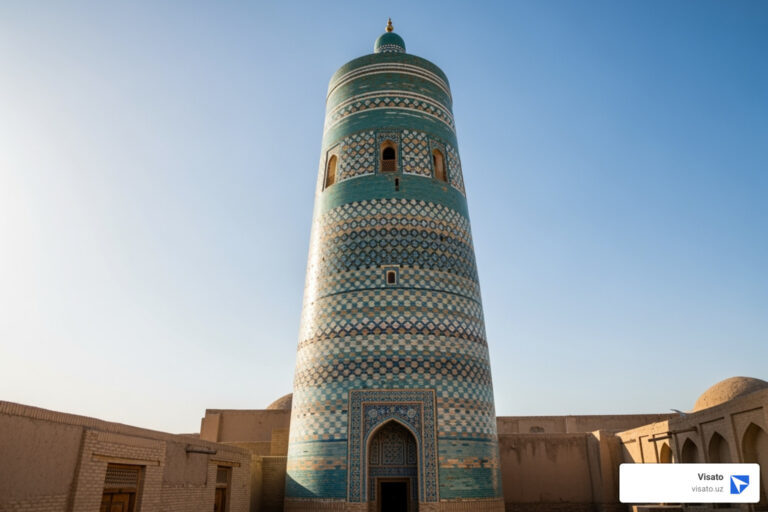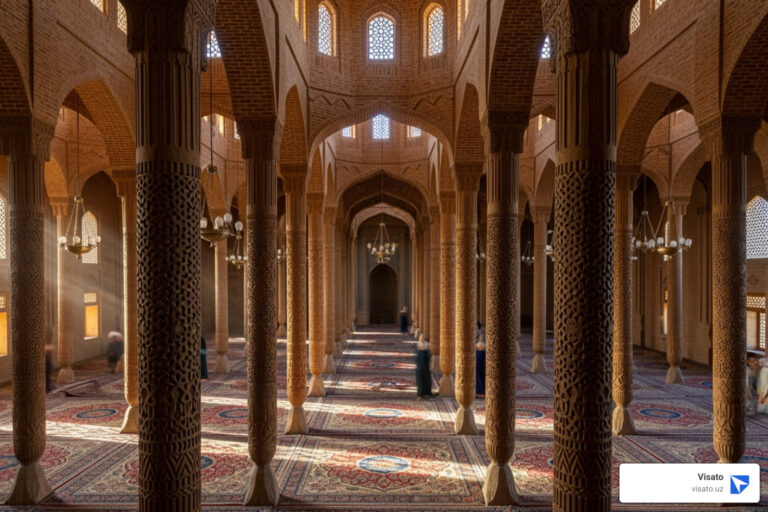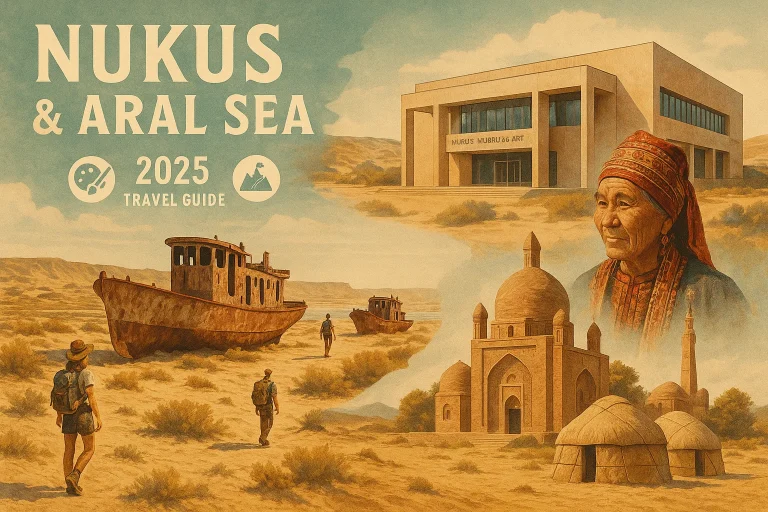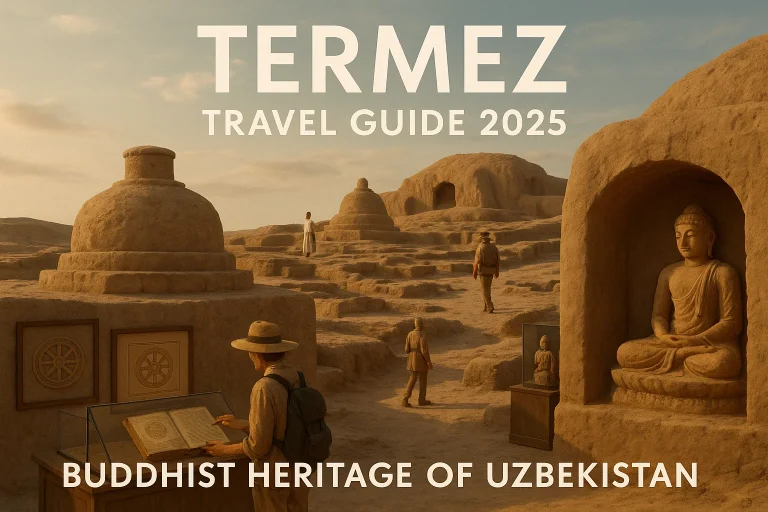Why the Kalta Minor Minaret Captures Every Traveler’s Imagination
The Kalta Minor Minaret stands as one of Central Asia’s most striking architectural mysteries—a brilliant turquoise tower that was meant to touch the sky but instead became famous for remaining unfinished. Rising just 29 meters above the ancient streets of Khiva, this gleaming monument tells a story of ambitious dreams cut short by fate.
Quick Facts About the Kalta Minor Minaret:
- Location: Itchan Kala (old town), Khiva, Uzbekistan
- Current Height: 29 meters (95 feet)
- Intended Height: 70-80 meters (some sources say up to 110 meters)
- Construction Period: 1852-1855 (stopped abruptly)
- Base Diameter: 14.2 meters
- Unique Feature: Only minaret in Central Asia entirely covered in glazed tiles
- Meaning: “Kalta Minor” translates to “Short Minaret”
- Status: Cannot be climbed; viewed from exterior only
Commissioned by Muhammad Amin Khan in 1851, this minaret was designed to become the tallest in the Muslim world. Instead, construction halted in 1855 when the khan died in battle near Sarakhs, leaving behind a squat, barrel-shaped structure that paradoxically became more iconic than any completed tower might have been.
Today, the Kalta Minor’s brilliant turquoise and blue glazed tiles make it the most photographed landmark in Khiva. The minaret sits prominently in the main square of Itchan Kala, a UNESCO World Heritage site, right next to the Muhammad Amin Khan Madrasah.
As Nariman Huseynov with over 5 years of experience helping travelers visit Uzbekistan, I’ve guided thousands of visitors to remarkable sites like the Kalta Minor Minaret through streamlined e-visa services. This guide will help you understand why this unfinished monument deserves a place on your Uzbekistan itinerary.
The Grand Vision of Muhammad Amin Khan
Picture Khiva in the 1850s—a thriving city on the ancient Silk Road, where ambitious rulers competed to leave their mark on history through breathtaking architecture. This was Muhammad Amin Khan, the ruler of the Khanate of Khiva, and he had a vision that would literally reach for the heavens.
In 1852, Muhammad Amin Khan launched what was meant to be his crowning achievement: a minaret so magnificent it would become the tallest structure in the entire Muslim world. The Kalta Minor Minaret—or as it was originally called, the Kok Minor (Blue Minaret)—was designed to soar between 70 and 80 meters into the sky. Some historical accounts even suggest the khan dreamed of reaching 110 meters, a height that would have been absolutely staggering for its time.
This wasn’t just about building tall. It was about making a statement that would echo across Central Asia and beyond. The minaret would stand beside the massive Muhammad Amin Khan Madrasah, creating an architectural complex that would cement Khiva’s reputation as a center of Islamic learning and artistic brilliance.
If you’re planning to witness this remarkable piece of history yourself, getting there starts with the right paperwork. We’ve put together helpful information about Uzbekistan e-visa requirements to make your journey as smooth as possible.
A Tower to See Bukhara
Here’s where legend and ambition blend beautifully together. Local stories tell of Muhammad Amin Khan’s ultimate dream: to build a minaret so impossibly tall that he could stand at its peak and gaze across the desert to see the rival city of Bukhara, roughly 450 kilometers away.
Now, let’s be honest—the physics of that don’t quite work out. But the legend captures something real about the khan’s spirit. This was a man who thought big, who wanted his city to outshine every other center of power in Central Asia.
At the time, cities across the region were locked in an unofficial competition of architectural one-upmanship. Bukhara had its famous Kalyan Minaret, already a towering symbol of that city’s prestige. Muhammad Amin Khan wanted to top them all—not just in height, but in sheer visual impact and innovative design.
The Kalta Minor Minaret was designed to be part of a grander vision. Together with the Muhammad Amin Khan Madrasah—one of the largest educational institutions in Central Asia—these structures would transform Khiva’s skyline and announce to the world that this Silk Road city was a force to be reckoned with.
The Sudden Halt in 1855
Then, as suddenly as it began, everything stopped.
In 1855, just three years after construction started, Muhammad Amin Khan was killed in battle near Sarakhs during a military campaign. His death sent shockwaves through the khanate and brought an immediate end to his ambitious building projects.
Without their visionary patron, the workers laid down their tools. The funding dried up. The political will to continue such a massive undertaking simply evaporated. The Kalta Minor Minaret stood frozen at approximately 29 meters—less than half its intended height, a fraction of what should have been.
The unfinished tower quickly earned a new name: “Kalta Minor,” which translates directly to “Short Minaret.” It’s almost ironic—what was meant to be the tallest minaret in the Muslim world became famous for being unfinished.
But here’s the beautiful twist: this abrupt ending didn’t diminish the minaret’s legacy. If anything, it improved it. The Kalta Minor became something more poignant than a completed tower ever could have been—a stunning reminder that even the grandest dreams can be cut short by fate, and that sometimes what we leave unfinished tells the most compelling story of all.
Architectural Splendor: Design and Dazzling Tilework
Even though it was never finished, the Kalta Minor Minaret stands as a breathtaking example of Islamic architectural artistry. What makes this tower truly special—and what draws photographers from around the world—is its completely tiled exterior. It’s the only minaret in all of Central Asia that’s entirely covered in glazed tiles from bottom to top, creating a shimmering jewel in the heart of Khiva’s old city.
The surface of the minaret is dressed in an intricate mosaic of glazed bricks and majolica tiles, predominantly in stunning shades of turquoise and deep blue. White and green accents weave through the design, creating visual depth and movement. The tiles form complex geometric patterns called gireh, a distinctive feature of Central Asian craftsmanship that’s been perfected over centuries.
What’s remarkable is how well these tiles have aged. Despite facing over 150 years of scorching summers and harsh winters, the colors remain incredibly vibrant. The majolica and glazed tiles look nearly as fresh as the day they were laid in 1855, their brilliance undiminished by time.
The patterns themselves seem oddly complete, as if the artisans somehow knew the tower would remain at this height. The geometric designs wrap around the structure in perfect harmony, creating a visual story that feels finished even though the tower itself is not.
While the Kalta Minor Minaret has its own unique character, it’s worth considering how it fits into the broader story of Islamic architecture. The Comparison to the Qutb Minar in Delhi shows how different regions developed their own distinctive styles. The Qutb Minar soars skyward with red sandstone and marble, while the Kalta Minor impresss with its turquoise tiles and compact form. Both represent the pinnacle of their era’s architectural ambition.
The Unmistakable Turquoise Icon
If you’ve seen any photos of Khiva, chances are the Kalta Minor Minaret was front and center. This gleaming turquoise tower has become the city’s most recognizable symbol, its brilliant blue hues instantly calling to mind the ancient Silk Road city.
The unique color palette sets it apart from every other minaret you’ll see in Central Asia. While others might be built from brick or stone in earth tones, the Kalta Minor blazes with color—turquoise, cobalt blue, white, and green tiles that seem to glow in the sunlight. Combined with its unusual squat shape, it’s impossible to mistake for anything else.
Photographers absolutely love this minaret, and for good reason. As the sun moves across the sky, the glazed tiles catch the light in different ways, shifting from deep blue in the shadows to brilliant turquoise in direct sunlight. The contrast against the clear blue Central Asian sky is simply stunning.
The minaret underwent careful restoration work in 1996-97, which preserved both its structural integrity and the brilliance of its tilework. This renovation ensured that future generations—including you—can experience the monument’s beauty almost exactly as it appeared when construction stopped in 1855. The restoration team did excellent work maintaining the authentic character while protecting the tiles from further weathering.
Today, it’s the most photographed landmark in all of Khiva, a visual icon that captures the imagination of every traveler who visits.
Dimensions of an Unfinished Giant
Here’s where the Kalta Minor Minaret gets really interesting. Despite its nickname meaning “Short Minaret,” the dimensions of this structure are genuinely impressive and reveal just how ambitious Muhammad Amin Khan’s original plan truly was.
The most striking measurement is the base diameter: a massive 14.2 meters across. To put that in perspective, that’s about the width of a four-lane road. This incredibly wide base wasn’t just for show—it was engineered to support a tower that would have reached 70 to 80 meters high, possibly even more.
The foundation is equally remarkable, extending 15 meters deep into the ground. That’s about as tall as a five-story building, buried beneath the surface. This deep foundation was absolutely necessary to anchor what would have been one of the tallest structures in the Islamic world.
When you stand next to the minaret and see how wide it is compared to its current height of just 29 meters, you begin to understand the scale of what was planned. The proportions look unusual because they were designed for a tower three times taller. If it had been completed, the Kalta Minor Minaret would have had truly monumental proportions, visible from miles away across the desert.
This is exactly why it earned the name “Kalta Minor”—the contrast between that enormous base and the relatively modest height creates a squat, barrel-like appearance. It’s this very paradox that makes the minaret so fascinating. The unfinished giant stands as a permanent reminder of grand dreams and the unpredictability of history.
A Practical Guide to Visiting the Kalta Minor Minaret
Visiting the Kalta Minor Minaret is an essential part of any trip to Khiva, offering a blend of historical intrigue and stunning visual beauty. As a prominent landmark within Itchan Kala, the ancient walled city and a UNESCO World Heritage site, it’s incredibly accessible and forms a natural centerpiece for exploring Khiva’s other treasures.
Before you set off on your Uzbek adventure, getting your travel documents sorted makes everything smoother. We offer a guide to getting an Uzbekistan e-visa to help streamline your entry into this fascinating country, so you can focus on the experience rather than paperwork.
Location, Tickets, and Accessibility
The Kalta Minor Minaret stands proudly in the main square of Itchan Kala, directly in front of the Muhammad Amin Khan Madrasah. You literally can’t miss it—that brilliant turquoise tower will catch your eye the moment you enter the old city gates.
Getting to the minaret couldn’t be easier. Itchan Kala is compact and entirely walkable, with the minaret serving as a natural landmark to orient yourself. To enter the walled city, you’ll need to purchase an entrance ticket for Itchan Kala itself. This ticket allows you to wander the streets and view the Kalta Minor Minaret from the outside, which is actually the only way to see it.
Here’s something important to know: you cannot climb the minaret or go inside. It’s closed to the public for safety reasons, given its unfinished state. But honestly, this doesn’t diminish the experience at all. The minaret’s beauty is meant to be appreciated from ground level, where you can truly take in the stunning tilework and contemplate its fascinating unfinished story.
The location is perfect for exploring other nearby attractions. The Kunya Ark Fortress sits just steps away, offering incredible views from its watchtower. The historic Juma Mosque, with its forest of intricately carved wooden pillars, is an easy walk from the square. And of course, the massive Muhammad Amin Khan Madrasah right next door provides wonderful context to the minaret’s history. You can easily spend hours wandering between these sites, each one adding another layer to your understanding of Khiva’s rich past.
Best Times for Photography
If you’re hoping to capture the Kalta Minor Minaret at its most spectacular, timing really does matter. Those vibrant tiles respond beautifully to changing light, changing throughout the day.
The golden hours—sunrise and sunset—are absolutely magical. During these times, the low-angle sun bathes the minaret in warm, soft light that makes the turquoise and blue tiles practically glow. The colors become richer, the geometric patterns gain stunning depth, and shadows add drama to your shots. If you can only visit once, make it sunset. The way the fading light plays across those glazed tiles is simply breathtaking.
Don’t overlook nighttime photography either. After dark, the minaret is beautifully illuminated, creating an entirely different atmosphere. The night illumination transforms it into a glowing guide against the dark sky, offering opportunities for dramatic long-exposure shots that you simply can’t get during daylight hours.
Photography Tips for the Kalta Minor:
- Arrive early for sunrise or stay through sunset to catch that perfect golden hour light
- Bring a tripod for night shots, and use longer exposures with higher ISO settings to capture the illuminated minaret
- Walk completely around the minaret and explore different vantage points in the square—don’t just shoot from one spot
- Try compositions that include the adjacent Muhammad Amin Khan Madrasah for scale and architectural context
- For daytime shots, use an aperture around f/8-f/11 to keep the intricate tile details sharp
- Always be respectful of local customs and ask permission before photographing people
With these tips in mind, you’ll be well-equipped to capture the vibrant beauty and unique character of this remarkable monument.
Why is the Kalta Minor Minaret a Must-See?
Standing before the Kalta Minor Minaret for the first time, you’ll understand why it captures the imagination of every traveler who visits Khiva. This isn’t just another beautiful building to check off your list—it’s a place that tells a story so human, so compelling, that it resonates across centuries.
The minaret’s cultural significance runs deep. It stands as a powerful symbol of ambition and fate, a reminder that even our grandest plans can take unexpected turns. Muhammad Amin Khan dreamed of building the tallest minaret in the Muslim world, a tower that would make Khiva legendary. Instead, his sudden death left us with something perhaps more memorable—a brilliant turquoise monument to dreams interrupted, to potential unfulfilled, to the beautiful imperfection of human endeavor.
This is what makes the Kalta Minor Minaret so captivating. Unlike completed minarets that speak of achievement, this one whispers a different story. It invites you to imagine what might have been while appreciating what is—a masterpiece in its own right, its squat form and dazzling tilework creating an architectural story unlike any other in Central Asia.
At the heart of Khiva, surrounded by the ancient walls of Itchan Kala, the minaret serves as a natural gathering point. Its vibrant blues and turquoises draw you in from every corner of the old city. You’ll find yourself returning to it again and again during your visit, seeing it in different light, from different angles, each time finding something new in its intricate patterns.
For anyone planning a trip to Uzbekistan, this minaret represents an unforgettable travel experience. It’s photogenic, yes, but it’s also deeply moving. It connects you to the Silk Road’s golden age, to the ambitions of ancient rulers, and to the skilled craftsmen who created something so beautiful it still takes our breath away nearly 170 years later.
This is why the Kalta Minor Minaret deserves its place as a must-see Uzbekistan attraction. It offers more than visual splendor—it offers perspective, wonder, and a story that stays with you long after you’ve left Khiva’s ancient walls.
Frequently Asked Questions about the Kalta Minor Minaret
As you plan your visit to this captivating landmark, you’re bound to have questions. The Kalta Minor Minaret sparks curiosity in everyone who sees it, and over the years, we’ve heard the same wonderings from countless travelers. Let’s address the most common questions to help you appreciate this magnificent structure even more.
What does “Kalta Minor” mean?
If you’re wondering about the name, you’re not alone—it’s one of the first things visitors ask about. “Kalta Minor” translates directly from Uzbek to “Short Minaret,” a name that captures both irony and reality. This wasn’t what Muhammad Amin Khan had in mind when he commissioned the structure, but after construction stopped, the name stuck.
The original name was actually “Kok Minor,” meaning “Blue Minaret,” which beautifully described the stunning turquoise and blue tilework that covers its surface. The shift from “Blue” to “Short” tells its own story—from a vision of soaring grandeur to the reality of what remains. It’s a name that’s both descriptive and a bit cheeky, acknowledging that this unfinished tower never reached its intended glory. Yet somehow, this “shortcoming” has only made it more beloved and memorable.
Can you go inside or climb the Kalta Minor Minaret?
This is probably the most frequently asked question we hear, and unfortunately, the answer is no. The Kalta Minor Minaret is strictly an exterior monument. There is no public access inside, and you cannot climb it. While this might initially disappoint some adventurous visitors, there are good reasons for this restriction.
The minaret’s structure and its complete covering of glazed tiles require careful preservation. Additionally, safety considerations play a role—remember, this is an unfinished structure that was never intended to function as a traditional minaret with a muezzin’s call to prayer. The good news? You don’t need to climb it to appreciate its beauty. The Kalta Minor’s magic is fully on display from ground level, where you can admire every intricate detail of its tilework, photograph it from multiple angles, and absorb the full visual impact of its turquoise brilliance against the Khivan sky.
What is the main legend about why it’s unfinished?
The mystery of why the Kalta Minor Minaret remains incomplete has spawned both historical fact and colorful folklore. Understanding both gives you a richer appreciation of this monument.
The historical truth is straightforward: construction halted abruptly in 1855 when Muhammad Amin Khan died in battle near Sarakhs. His death meant the end of patronage for this ambitious project. Without his vision, political backing, and financial resources, the massive undertaking simply stopped. The workers laid down their tools, and the minaret remained at its current 29 meters, forever frozen in time.
But history rarely travels alone—it brings legends with it. The most popular folklore surrounding the unfinished minaret involves the master architect and a tale of rivalry between khans. According to this story, the Emir of Bukhara heard about the magnificent minaret being built in Khiva and approached the architect with an offer: come to Bukhara and build an even taller, more spectacular minaret there. When Muhammad Amin Khan finded this potential betrayal, he was furious. Fearing that his architect would finish the Khiva minaret and then create an even grander structure for his rival, the khan allegedly ordered the architect’s execution. In some versions, the architect was to be thrown from the top of his own creation. To save his life, the architect fled Khiva under cover of darkness, leaving the minaret forever unfinished.
It’s a dramatic tale that captures the intense rivalries between Central Asian khanates and the high stakes of architectural prestige during that era. While the legend of the fleeing architect is almost certainly embellishment, it speaks to deeper truths about power, ambition, and the fierce competition that drove these magnificent building projects. The reality is probably less theatrical but no less poignant—a great vision cut short by the simple, brutal fact of mortality.
Conclusion
Standing before the Kalta Minor Minaret, you’re not just looking at an unfinished tower—you’re witnessing a piece of history frozen in time. This brilliant turquoise monument has become far more than what Muhammad Amin Khan originally envisioned. In its incompleteness, it tells a more powerful story than any finished structure could: a tale of grand ambition, unexpected fate, and the enduring beauty of human aspiration.
The Kalta Minor Minaret captures the essence of what makes Khiva so magical. Its dazzling tiles still shine as brightly as they did in 1855, and its squat, distinctive form has become the heart of this ancient Silk Road city. Whether you’re drawn by its architectural brilliance, its intriguing legends, or simply the way it glows at sunset, this “Short Minaret” promises to be one of the most memorable moments of your Uzbekistan adventure.
Now that you’re ready to experience this captivating landmark for yourself, let’s make sure the practical side of your journey is just as smooth as your visit will be inspiring. At Visato.uz, we understand that dealing with visa applications can feel overwhelming when you’re excited about exploring ancient cities and stunning monuments. That’s exactly why we’ve dedicated ourselves to making the process simple and stress-free.
We handle your Uzbekistan e-visa application from start to finish, delivering your approved visa in just 2-3 business days. Our team is available 24/7 to answer questions and guide you through every step, so you can focus on planning which photo angle of the Kalta Minor Minaret you’ll capture first, not on paperwork.
The turquoise tiles of Khiva are waiting for you, and we’re here to help you get there. Apply for your Uzbekistan e-visa today and take the first step toward standing in that ancient square, gazing up at one of Central Asia’s most unforgettable monuments. Your Uzbek adventure is closer than you think!

